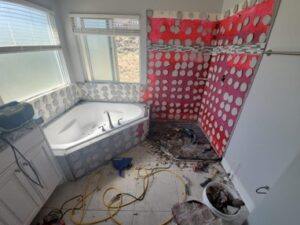Dedicated to Quality Craftsmanship
Setting standards and leading the way in the greater San Francisco Bay Area tile and stone industry.
What is Spot Bonding?
What is “spot bonding,” and why should you be on the lookout for it?
Spot bonding is a term frequently used in the tile industry, usually in a negative context.
Here is a typical scenario:
Untrained installers using cement-based bonding mortar as a (supposed) leveling agent, apply blobs of bonding mortar to the back of the tile and then slap it on the wall or floor they are tiling.

Why do some tile installers spot bond?
Who knows why they do it…..They may think they are installing quicker by skipping the necessary troweling method; they may think it is the solution to dealing with an uneven substrate; it may simply be “the way we’ve always done it.”
Whatever the reason, spot bonding is never the correct way to apply bonding mortar.
What is the proper way to apply the bonding mortar?
ANSI A108 and the TCNA Handbook, offer detailed information on the proper application of bonding mortar as a bonding agent for tile.
In brief–bonding mortar needs to be applied directly to the substrate, first by “burning in” the mortar, and then by using a properly notched trowel to apply and directionally trowel the mortar. Trowel ridges should all go the same direction, usually parallel with the longest side of the tile (if there is one). By using this method, the tile is then pressed into the applied bonding mortar uniformly, moved back and forth with sufficient movement to collapse the ridges and allowing any trapped air to escape out the edge of the tile, thus allowing the proper bond between tile and substrate. NOTE: for an excellent video showing proper troweling technique, checkout this link to the NTCA’s video, “Trowel and Error.”
Why is proper application of bonding mortar so important?
When bonding mortar is improperly applied to the substrate, this can create many situations which can lead to an eventual failure.
Examples:
Edge lippage can occur due to the uneven shrinking of the mortar bed as it dries.
Inadequate mortar coverage can allow water intrusion at interior water areas and exterior installations.
Lack of mortar coverage can lead to cracking tile on floors when weight or point loads are applied to the areas lacking sufficient mortar coverage.
For a deeper look into the spot bonding phenomenon and its effect on a tile installation, see this excellent article by Will White with Custom’s Building Products.
What should you do if you think your tile was improperly installed?
If you notice, excessive lippage, hollow sounds or broken tiles, there is a chance that your tile may have been improperly installed. To assess your situation, you may need to have your tile inspected. For more information, check out our inspections page.
